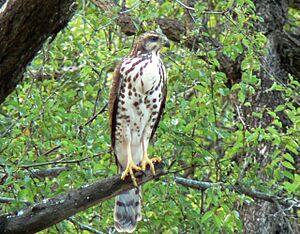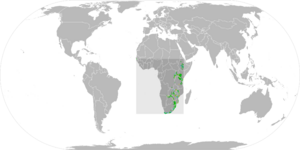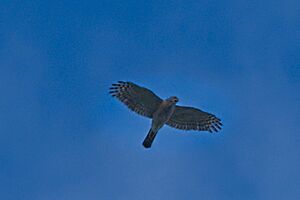African goshawk facts for kids
Quick facts for kids African goshawk |
|
|---|---|
 |
|
| Captive adult female | |
 |
|
| immature female | |
| Conservation status | |
| Scientific classification | |
| Subspecies | |
|
|
 |
|
| Global range Year-Round Range Summer Range Winter Range | |
| Synonyms | |
|
Falco tachiro Daudin, 1800 |
The African goshawk (Accipiter tachiro) is a cool bird of prey that lives in Africa. It's part of a group of birds called Accipiter, which are known for being fast and agile hunters. This bird belongs to the family Accipitridae, which includes many hawks, eagles, and kites.
Contents
What Does the African Goshawk Look Like?
The African goshawk is a medium-sized hawk. It's mostly grey and reddish-brown. Like other birds in its group, it has wide wings and a long tail.
Adult birds are grey on top. Males are usually darker grey than females. Their bellies are whitish with reddish-brown stripes. These stripes are clearer on males. The feathers under their wings are light reddish-brown, sometimes fading to white. Their flight feathers and tail can be dark brown or grey. They have faint grey stripes on top and white with grey stripes underneath.
The goshawk's beak is black. The skin around its beak (called the cere) is greenish-grey. Its eyes are yellow, and its legs and feet are also yellow.
Young goshawks are brown on top. Their bellies and sides are whitish with bold brown blotches.
Size and Weight
Female goshawks are larger than males. Females weigh about 270 to 510 grams (0.6 to 1.1 pounds). Males are smaller, weighing about 150 to 340 grams (0.3 to 0.7 pounds).
A goshawk's wingspan is about 1.7 times its total body length. For males, the wingspan is about 43.7 to 57.2 centimeters (17.2 to 22.5 inches). For females, it's about 53.6 to 69.8 centimeters (21.1 to 27.5 inches).
What Does it Sound Like?
This bird can be quite noisy, especially when it's showing off. Its special call sounds like two stones being tapped together. It makes this clicking sound every 2 to 3 seconds.
Where Do African Goshawks Live?
African goshawks live across a large part of Africa. You can find them from the Western Cape in South Africa all the way north to the southern Democratic Republic of Congo. They also live in eastern Africa, Somalia, and southern Ethiopia. They even live on islands like Mafia, Unguja (Zanzibar), and Pemba.
What Kind of Places Do They Like?
African goshawks usually live in forests and thick woodlands. They can be found in both lowlands and mountains. They also like forests along rivers and in valleys. Sometimes, they live in tree farms, parks, and big gardens. They can live in both wet and dry forests, even in small, isolated patches of trees.
How Do African Goshawks Behave?
African goshawks often fly high above the treetops in the morning. They do this in a special display flight. They beat their wings slowly, then glide. Sometimes they fly so high you can only hear their regular clicking call.
Hunting and Food
These birds are skilled hunters. They mostly eat other birds, even larger ones like hornbills or francolins. They also hunt small mammals, lizards, and sometimes insects.
They are ambush hunters. This means they wait quietly on a perch. Once they spot their prey, they swoop down quickly to catch it. Sometimes, a pair of goshawks will hunt together. They might do this when there are many prey animals in one spot, like at bat roosts or weaver bird colonies.
Nesting and Raising Young
African goshawks are very protective of their territory. During courtship, both the male and female fly together. They fly in a wavy pattern and call loudly. Sometimes they end their flight with a fast dive.
The female builds the nest. She makes a platform of sticks and lines it with fresh leaves. She might also use pine needles, lichen, and mistletoe. Nests are usually built on a tree branch, away from the main trunk. Goshawks like to nest in dense leaves. They might also build their nest on top of an old Hadeda ibis nest. Sometimes, they even take over the nest of a little sparrowhawk (Accipiter minullus) instead of building their own.
They lay one to three eggs between July and December. Most eggs are laid from September to November. The female does most or all of the incubating, which takes about 35 to 37 days. The male regularly brings her food during this time.
Both parents feed the chicks. The young birds leave the nest when they are about 30 to 35 days old. They stay near the nest tree for about six more weeks. They become fully independent about 1 to 3 months after leaving the nest.
Who Hunts the Goshawk?
Even goshawks can be hunted by other animals. Some birds that prey on African goshawks include the black sparrowhawk (Accipiter melanoleuca), the tawny eagle (Aquila rapax), the Cape eagle-owl (Bubo capensis), the lanner falcon (Falco biarmicus), and the peregrine falcon (Falco peregrinus).
Different Types of African Goshawks
There are three types, or subspecies, of African goshawks:
- Accipiter tachiro tachiro: Found from southern Angola to Mozambique and South Africa.
- Accipiter tachiro sparsimfasciatus: Found from Somalia to northern Democratic Republic of the Congo, Angola, Zambia, and Mozambique.
- Accipiter tachiro pembaensis: Found only on Pemba Island.



